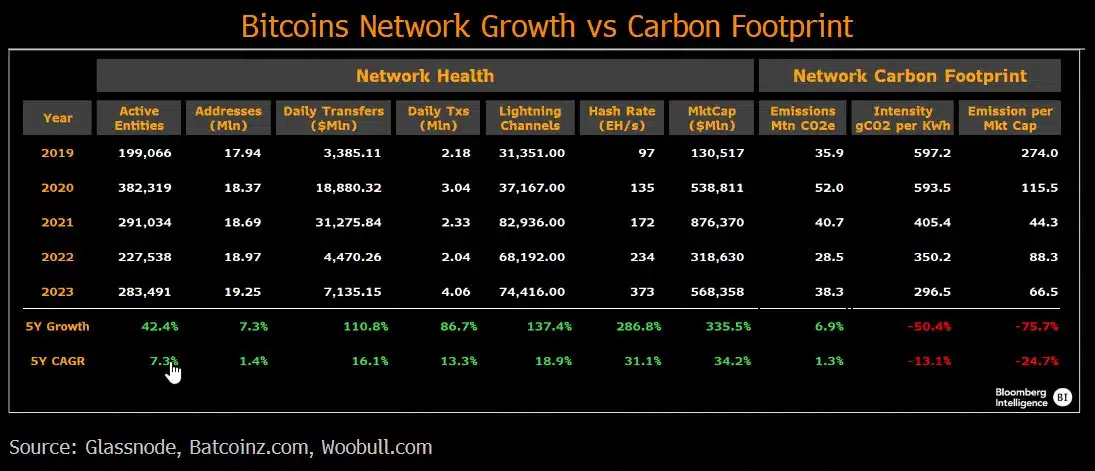How Bitcoin debunks energy concerns while sustaining growth

- Sustainable energy sources now account for more than 50% of Bitcoin mining.
- Emissions relative to Bitcoin’s market value plunged by 75% over the last four years.
Over the years, Bitcoin’s [BTC] stupendous network growth has come hand-in-hand with the criticism around its significantly increased power consumption and greenhouse emissions. This very issue has snowballed into a major sticking point between climate activists and Bitcoin maximalists, with the former raising the question – Will Bitcoin production be environmentally sustainable in the long run?
Read BTC’s Price Prediction 2023-24
Unique correlation comes to light
According to Bloomberg crypto market analyst Jamie Coutts, a symbiotic relationship was shaping up between Bitcoin network’s expansion and the green energy transition.
As evident from the stats below, while the network has grown in practically all key performance indicators (KPIs) of on-chain activity, carbon footprints have continued to decline, much to the delight of Bitcoin supporters.
This negative correlation was a result of miners’ preference for cheaper and cleaner sources of energy to drive their mining rigs, as per Jamie Coutts. He said,
“With energy constituting well over 50% of mining’s op cost, the incentive to acquire the cheapest energy sources is contributing to the network’s rising hash rate while simultaneously reducing the industry’s emissions or carbon intensity.”
Demand for renewables shoots up
Over the years, the share of renewable sources like hydropower solar and wind have gone up considerably. Coutts emphasized how these sustainable sources now account for more than 50% of Bitcoin mining consumption, citing data from climate-tech venture capitalist Daniel Batten.
This remarkable transition could be linked to a geographic shift in mining activities. Countries like China used to be the epicenter of BTC mining at one point in time. However, it ceded its position to the U.S. after a blanket ban on cryptocurrency mining in May 2021.
China, along with other Asian countries like Kazakhstan, are regions where fossil fuels are heavily subsidized. This incentivized miners to exploit these resources, resulting in higher carbon footprints.
But as the mining activity has moved to the U.S., things have changed. The south-central state of Texas has dished out favorable policies and tax incentives to attract miners to its wind and solar power.
Furthermore, the economic benefits of renewables couldn’t be stressed enough. According to a report by the International Renewable Energy Agency (IRENA), cost of electricity generation from wind, solar, and geothermal sources fell sharply in 2022.
For comparison, the new-age solar photovoltaics (PV) were found to be 29% less expensive than the cheapest fossil fuel-fired solution in 2022.
Greenhouse emissions drop despite network growth
Another way to analyze the inverse relation between emissions and network growth was through the emission per market cap metric. As indicated clearly, emissions relative to Bitcoin’s market value plunged significantly by 75%.
The counter-argument that could be made here is that Bitcoin’s value has also seen a sharp drawdown from its 2021 peaks. Indeed, BTC was 60% below its all-time high (ATH) at the time of writing, per CoinMarketCap data.
However, the fall in market cap didn’t impede Bitcoin’s network growth. In fact, a recent update from the on-chain analytics firm Glassnode revealed that ownership continued to rise to new highs on a daily basis.
? #Bitcoin $BTC Number of Addresses Holding 0.01+ Coins just reached an ATH of 12,454,017
Previous ATH of 12,453,322 was observed on 20 September 2023
View metric:https://t.co/oyguxpb7S6 pic.twitter.com/6roEN4EQM5
— glassnode alerts (@glassnodealerts) September 21, 2023
As the network has grown in size, so has the need for more miners to keep the system secure and decentralized. As per the data cited, Bitcoin’s global hash rate has nearly tripled over the last four years.
However, we have yet to see a proportional increase in the carbon footprints.
Is your portfolio green? Check out the BTC Profit Calculator
Researchers studying Bitcoin’s emissions and power consumption have made substantial adjustments to their data modelling methodologies over the years.
Recently, the popular portal Cambridge Bitcoin Electricity Consumption Index (CBECI) revised BTC’s power consumption for 2021 and 2022. This resulted in a significant reduction in annual estimates.










